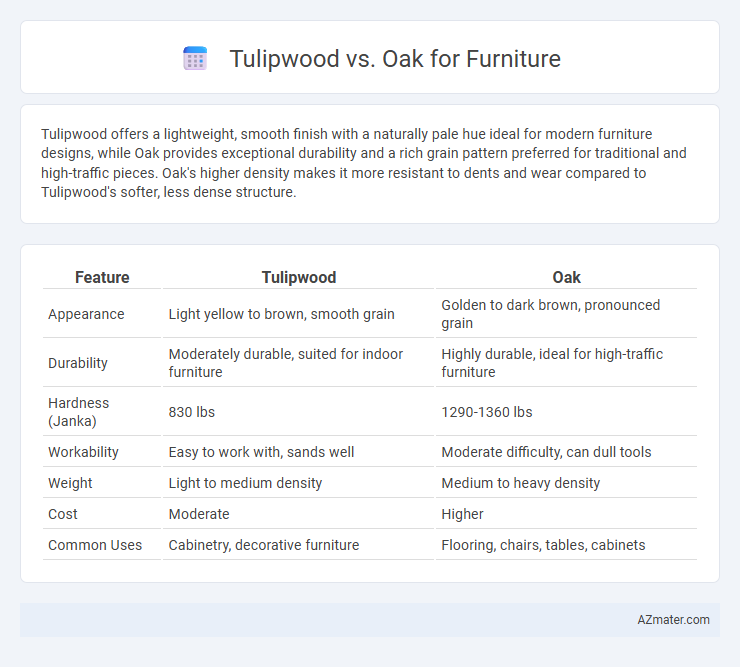Tulipwood offers a lightweight, smooth finish with a naturally pale hue ideal for modern furniture designs, while Oak provides exceptional durability and a rich grain pattern preferred for traditional and high-traffic pieces. Oak's higher density makes it more resistant to dents and wear compared to Tulipwood's softer, less dense structure.
Table of Comparison
| Feature | Tulipwood | Oak |
|---|---|---|
| Appearance | Light yellow to brown, smooth grain | Golden to dark brown, pronounced grain |
| Durability | Moderately durable, suited for indoor furniture | Highly durable, ideal for high-traffic furniture |
| Hardness (Janka) | 830 lbs | 1290-1360 lbs |
| Workability | Easy to work with, sands well | Moderate difficulty, can dull tools |
| Weight | Light to medium density | Medium to heavy density |
| Cost | Moderate | Higher |
| Common Uses | Cabinetry, decorative furniture | Flooring, chairs, tables, cabinets |
Introduction to Tulipwood and Oak for Furniture
Tulipwood, known for its creamy yellow to golden hue and fine grain, offers a lightweight yet durable option for modern furniture design. Oak stands out with its classic appeal, featuring a robust hardwood structure and prominent grain patterns that ensure longevity and strength in furniture pieces. Both woods provide unique aesthetics and functional qualities, making them popular choices in the furniture industry.
Origins and Botanical Characteristics
Tulipwood, derived from the Liriodendron tulipifera native to eastern North America, features a light, creamy-yellow heartwood with distinctive greenish or orange streaks, while oak, from the Quercus genus predominantly found in the Northern Hemisphere, presents a strong, coarse-grained texture in red or white varieties. Tulipwood's botanical characteristics include fast growth and large leaves shaped like tulip flowers, contrasting with oak's slow growth and lobed leaves that contribute to its dense, hard timber. These origin and botanical differences influence their appearance, durability, and suitability for various furniture styles and applications.
Appearance: Color, Grain, and Texture
Tulipwood features a warm, golden to reddish-brown color with a fine, straight grain that sometimes displays subtle figure variations, offering a smooth and uniform texture ideal for refined furniture pieces. Oak, available in red and white varieties, showcases prominent grain patterns with strong rays and knots, resulting in a coarse, textured surface that emphasizes rustic charm and durability. The distinct color palette and grain complexity of oak create a bold aesthetic, while tulipwood's consistent texture and softer hues provide a more elegant and contemporary appearance.
Strength and Durability Comparison
Tulipwood offers moderate strength and durability, making it suitable for light to medium-use furniture, while oak is renowned for its exceptional hardness and resistance to wear, ideal for heavy-use and long-lasting pieces. Oak's dense grain structure provides superior impact resistance and longevity compared to the softer, more porous tulipwood. When durability and strength are critical, oak consistently outperforms tulipwood in maintaining structural integrity over time.
Workability and Ease of Crafting
Tulipwood offers excellent workability due to its softer texture and straight grain, making it easier to cut, shape, and sand compared to oak. Oak, while durable and strong, is denser and more challenging to craft, often requiring specialized tools for detailed work. Furniture makers favor tulipwood for intricate designs and quicker projects, whereas oak is chosen for its robustness and long-lasting structural integrity.
Cost and Availability of Tulipwood vs Oak
Tulipwood typically costs less than oak, making it an economical choice for furniture projects. Oak is widely available and commonly used in furniture making, which often results in consistent pricing and easy sourcing. Tulipwood's availability varies regionally but is generally less abundant than oak, potentially affecting lead times and cost stability.
Environmental Impact and Sustainability
Tulipwood offers a sustainable alternative to oak due to its faster growth rate and smaller ecological footprint, allowing for more rapid forest regeneration. Oak, while durable and long-lasting, typically requires slower growth cycles and more intensive harvesting practices, leading to higher environmental impact. Choosing tulipwood supports more sustainable forestry management and reduces deforestation compared to oak, making it a preferable option for eco-conscious furniture production.
Suitability for Different Types of Furniture
Tulipwood offers a lightweight and moderately durable option ideal for furniture pieces such as cabinets, shelves, and decorative accents, where intricate detailing and a smooth finish are desired. Oak, known for its exceptional hardness and resistance to wear, is highly suitable for heavy-use items like dining tables, chairs, and flooring, providing long-lasting strength and a classic appearance. Choosing between tulipwood and oak depends on the furniture's functional demands and aesthetic preferences, with oak excelling in durability and tulipwood offering easier workability and a finer texture.
Maintenance and Longevity
Tulipwood offers moderate durability and requires regular sealing to prevent moisture damage, making its maintenance somewhat frequent compared to oak. Oak is highly durable and naturally resistant to wear, requiring less frequent upkeep but benefits from occasional polishing to maintain its finish and extend longevity. Both woods age gracefully, but oak's robust grain structure provides superior resilience in high-traffic furniture, ensuring long-term value.
Conclusion: Which Wood Suits Your Needs?
Tulipwood offers a lighter, more affordable option with smooth grain and warm hues ideal for modern, minimalist furniture, while oak provides exceptional strength, durability, and distinctive grain patterns suited for traditional and high-traffic pieces. Choose tulipwood for budget-friendly, decorative designs requiring moderate wear resistance, or select oak for long-lasting, sturdy furniture that withstands daily use and ages gracefully. Evaluating your specific needs for appearance, durability, and cost will determine the best wood type for your furniture project.

Infographic: Tulipwood vs Oak for Furniture
 azmater.com
azmater.com